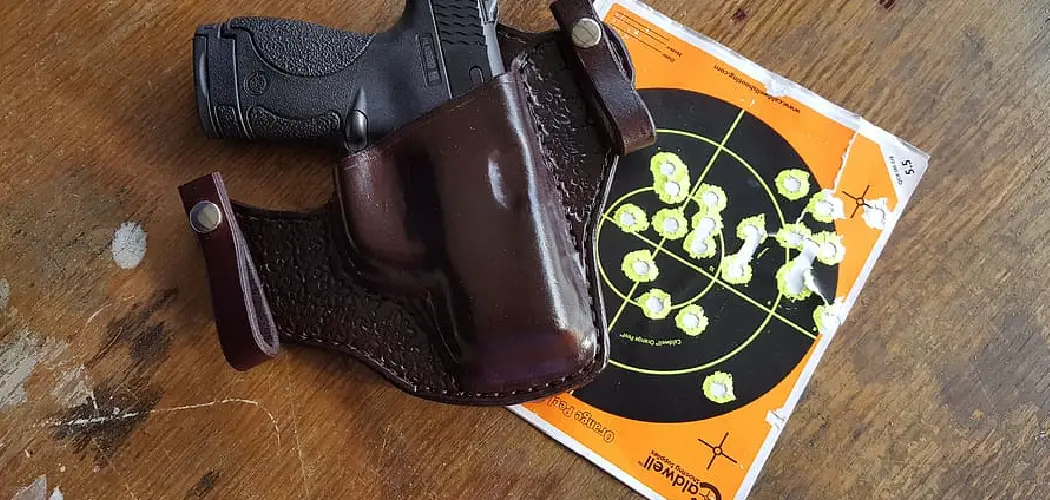A perfectly fitting leather holster is a cornerstone for comfort and practicality in concealed carry. However, newly acquired holsters may sometimes require a bit of adjustment to conform seamlessly to the contours of your firearm. Understanding how to stretch a leather holster effectively ensures an optimal fit, providing both security and ease of access.

In this guide, we embark on a journey through how to stretch leather holster, exploring various methods that cater to different holster designs and personal preferences. Whether you’re a seasoned gun owner or a newcomer to concealed carry, mastering these techniques will empower you to customize your leather holster, enhancing your overall firearm-carrying experience. Delve into the intricacies of holster stretching as we unveil the steps and considerations necessary for achieving a snug and tailored fit for your firearm.
Importance of Properly Fitted Leather Holsters
A properly fitted leather holster is not just a matter of comfort, but of safety as well. A snug fit ensures that your firearm is secure and prevents it from falling out or being removed by anyone other than the user. This is particularly essential in situations that require sudden movements.
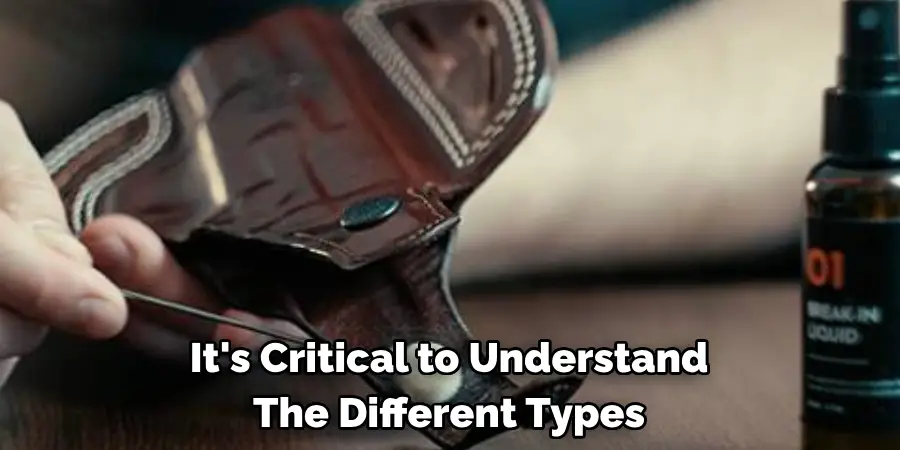
Additionally, a well-fitted holster will protect the finish of the gun by minimizing unnecessary friction. It also aids in a consistent draw, which is crucial for those who rely on their firearm for self-defense. A holster that fits well seems almost like an extension of your body, making concealed carry a more seamless part of your daily attire.
Benefits of Stretching Leather Holsters
Stretching a leather holster can significantly improve both the functionality and the longevity of the accessory. Firstly, it allows the leather to mold to the precise shape of your firearm, ensuring an exact fit that can enhance your weapon’s retention and quicken your draw times in critical situations. Additionally, methodically stretching your leather holster can prevent overstraining and reduce the risk of tearing, thereby extending the life of the holster. It also means the leather will become more pliable and comfortable against the body, contributing to a more comfortable carry throughout the day. Overall, investing time in properly stretching your leather holster translates into a more superior, reliable, and comfortable carry experience.
Understanding Leather Holsters
Leather, by its nature, is a durable and flexible material that has been utilized in the making of holsters for centuries. Its ability to conform and adapt to the shape of a firearm is unparalleled, which accounts for its enduring popularity among gun owners.
However, it’s important for users to recognize that leather can vary greatly in terms of quality and treatment. Full-grain leather, for instance, is considered the highest quality due to its strength and the fact that it retains the natural imperfections of the hide, which can add to the character of the holster. Moreover, the way a leather holster is constructed, stitched, and finished can all affect its fit and how it will stretch over time. Understanding these aspects is crucial for selecting a leather holster that will not only provide a perfect fit after stretching but will also stand the test of time.
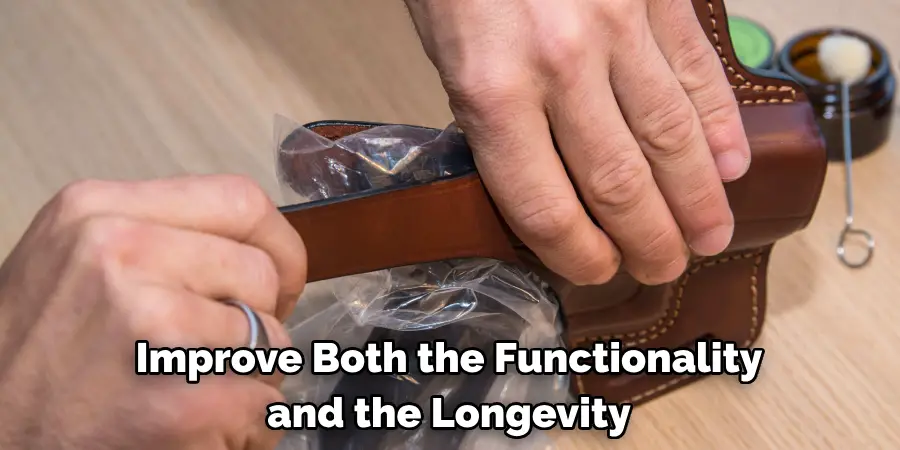
Types of Leather Used in Holsters
When selecting a leather holster, it’s critical to understand the different types of leather used and how they influence the fit and durability. The three main types of leather found in holster manufacturing are full-grain, top-grain, and genuine leather. Full-grain leather is the most sought-after due to its untouched surface which showcases the hide’s natural marks and makes each holster unique.
This leather is also the thickest and most durable, ideal for a robust holster that will last for years. Top-grain leather is slightly more processed, having had the very top layer removed to create a more uniform look while still retaining durability. This type is less bulky than full-grain and can make for a lighter, more comfortable holster. Lastly, genuine leather, despite its authentic-sounding name, is of lower quality. It is created from the remaining layers of hide after the top-grain has been removed and is often bonded with other materials.
While more cost-effective, it may not hold up as well under the rigors of daily use and may require more frequent stretching or adjustments. Each type of leather has its own unique properties and choosing the right one will depend on your specific needs and preferences for concealed carry.
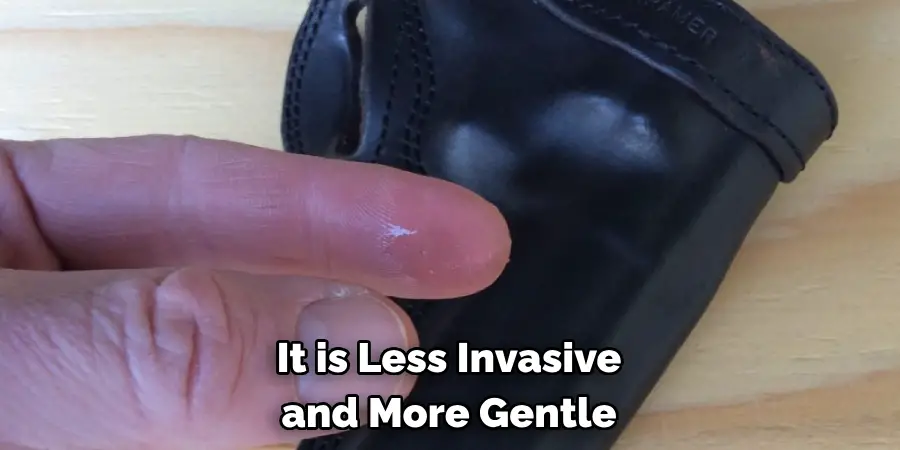
Characteristics of Leather Holsters
Leather holsters come with a distinctive set of characteristics that set them apart from other material options like Kydex or nylon. One of the most notable is their aesthetic appeal; the classic and timeless look of leather often improves with age, developing a patina that synthetic materials cannot replicate.
Leather’s natural give is another significant feature, accommodating slight variations in firearm models, which can be useful for gun owners with multiple similar-sized weapons. The breathability of leather also stands out, allowing air circulation that can make long-term carry more comfortable, particularly in warmer climates.
Moreover, leather holsters exhibit noise-dampening properties, proving advantageous in situations where stealth is necessary. Lastly, their customizability is evidenced in the ability of quality leather to be molded, dyed, and decorated, making for highly personalized carrying options. These characteristics collectively contribute to the ongoing popularity of leather holsters among enthusiasts who value tradition, appearance, and functionality.
Factors Affecting Fit and Comfort
Personal comfort and fit are subjective elements when it comes to selecting a leather holster, but they hinge on several key factors. Body type and size of the wearer can greatly influence how a holster sits against the skin and how easily it can be concealed under clothing. Personal carrying style, whether inside the waistband (IWB), outside the waistband (OWB), appendix, or shoulder, affects the pressure points and ease of access.
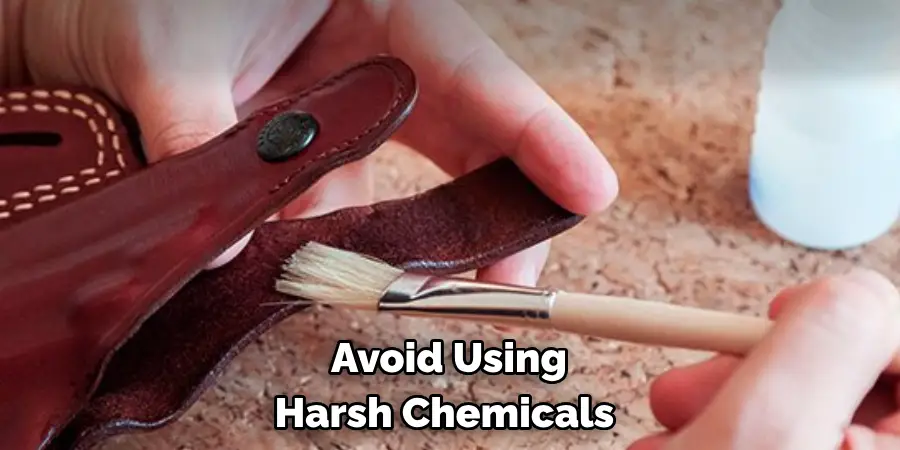
The quality of the belt used can also affect stability and comfort; a sturdy belt designed for carrying a firearm can make a significant difference. Furthermore, break-in period is a critical factor; like a new pair of boots, a leather holster requires time to mold to the owner’s firearm and body, which will improve fit over time.
Finally, maintenance routines such as regular cleaning and conditioning of the leather can keep the holster supple and comfortable for long-term use. Understanding these factors will assist owners in choosing a holster that promotes both a proper fit for their firearm and enduring comfort during carry.
10 Methods How to Stretch Leather Holster
1. Leather Conditioning:
Before attempting to stretch a leather holster, apply a quality leather conditioner to soften the material. This makes the leather more pliable and receptive to stretching. Use a clean cloth to evenly distribute the conditioner and let it absorb for the recommended time. Avoid using harsh chemicals or products containing alcohol, as they can damage the leather. While conditioning, also be sure to clean any dirt or debris from the holster to prevent it from becoming embedded in the leather during stretching.
2. Wet Forming:
Wet forming is a traditional method that involves moistening the leather to make it more malleable. Lightly dampen the interior of the holster with water or a leather-friendly solution. Insert the unloaded firearm into the holster, ensuring it’s wrapped in plastic to protect it from moisture. Allow the holster to dry while on the firearm, and as it does, it will mold to the shape of the gun.

Wet forming is a useful technique for creating custom-fit holsters, as it allows the leather to conform to the specific shape and size of the firearm. This can be especially beneficial for unique or non-standard firearms that may not have pre-made holsters available.
However, wet forming does come with some potential downsides. The moisture can potentially cause the leather to become stiff or brittle over time if not properly dried. It can also lead to discoloration or molding if the leather is not allowed to dry completely.
3. Leather Stretching Spray:
Leather stretching sprays are specially formulated to soften and expand leather fibers. Apply the stretching spray to the interior of the holster, following the product instructions. Insert the firearm, ensuring it is protected with a plastic wrap, and wear the holster until it dries. The leather will conform to the gun’s shape during this process. This method may take a longer time to achieve the desired fit compared to using stretching tools, but it is less invasive and more gentle on the leather. However, be sure to test the spray on a small, inconspicuous area of the holster first to check for any potential damage or color changes.
Leather stretching sprays can also be used to stretch out other leather items such as shoes, bags, and gloves. They are a versatile product and a handy tool for anyone who owns leather goods. It is important to choose a high-quality leather stretching spray that is specifically designed for this purpose to avoid any damage or discoloration to your items.
4. Heat Gun or Hair Dryer:
Controlled application of heat can help expedite the stretching process. Use a heat gun or a hair dryer on a low setting to warm the leather without causing damage. Once warmed, insert the unloaded firearm into the holster, ensuring not to overheat the leather.
The heat will make the leather more pliable for stretching. Though this method may be effective in stretching the leather, it is important to exercise caution and not overheat the leather as it can cause permanent damage. To avoid overheating, it is recommended to use short bursts of heat and check the leather’s temperature frequently.
5. Leather Holster Stretching Tools:
Invest in professional leather holster stretching tools, designed specifically for this purpose. These tools typically consist of wooden or metal blocks that fit inside the holster to stretch and shape the leather. Follow the tool’s instructions to ensure safe and effective stretching. Additionally, some tools may require the use of a heat source, such as a hairdryer or heat gun, to aid in the stretching process. Always use caution when using heat and follow all safety precautions.
When purchasing leather holster stretching tools, make sure to choose ones that are compatible with your specific type of holster. Different materials and designs may require different types of stretching tools. It is also important to invest in high-quality tools that will not damage the leather or affect the fit of your holster.
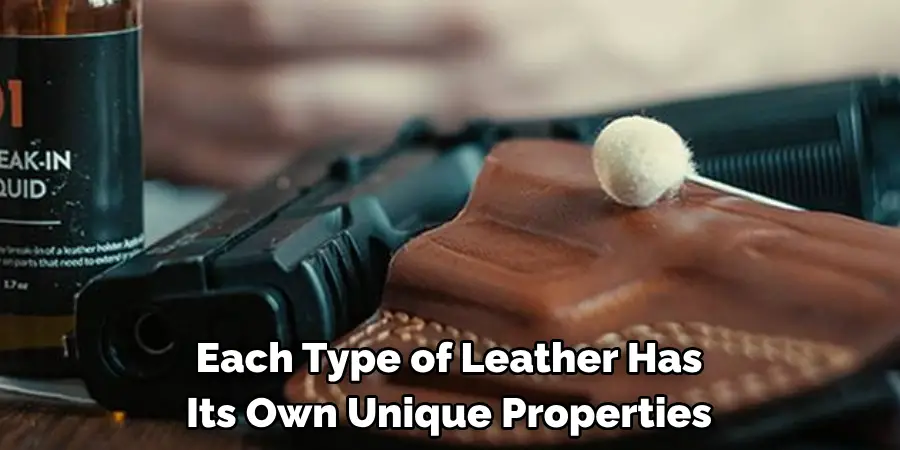
6. Leather Stretcher:
Leather stretchers are devices that can be adjusted to widen various leather items, including holsters. Place the stretcher inside the holster, adjust it to the desired width, and leave it in place for the recommended duration. This method is particularly effective for achieving an even and controlled stretch.
Additionally, leather stretchers can also be used to widen other leather items such as shoes and belts. They are especially useful for breaking in new leather items that may be too tight or uncomfortable to wear at first. By using a stretcher, the leather can gradually adjust and mold to the shape of your foot or body, making it more comfortable to wear over time.
7. Use of a Doffing Gun:
A doffing gun is a tool specifically designed for stretching holsters. It delivers controlled pressure to expand the holster gradually. Insert the doffing gun into the holster, following the manufacturer’s guidelines for pressure and duration. This method provides precise stretching, minimizing the risk of overstretching. It also allows for even stretching throughout the entire holster.
Moreover, doffing guns are suitable for use on both leather and synthetic materials, making them a versatile tool for all types of holsters. They can be used to stretch out tight spots or to create a custom fit for specific firearms. With regular use, a doffing gun can also help maintain the shape and integrity of your holsters, prolonging their lifespan.
Additionally, using a doffing gun eliminates the need for hand stretching, which can be time-consuming and inconsistent. This saves both time and effort, making it an efficient tool for professional holster makers or anyone who owns multiple holsters.
8. Plastic Bag Method:
For a DIY approach, insert a plastic bag into the holster, ensuring it covers the entire interior. Insert the unloaded firearm wrapped in another plastic bag. This creates a barrier between the firearm and the leather while allowing the plastic to expand, stretching the holster. Wear the holster until it dries, molding to the firearm’s shape. This method is best suited for leather holsters.
Some gun owners prefer this method as it not only stretches the holster but also prevents any moisture from being absorbed by the leather. However, it may take longer than other methods and may not be suitable for all types of holsters.
9. Leather Holster Insert:
Invest in a leather holster insert designed to facilitate stretching. These inserts are often made of hardwood or other durable materials. Insert the stretching tool into the holster and leave it in place for the recommended time. This method ensures uniform stretching and maintains the holster’s shape.
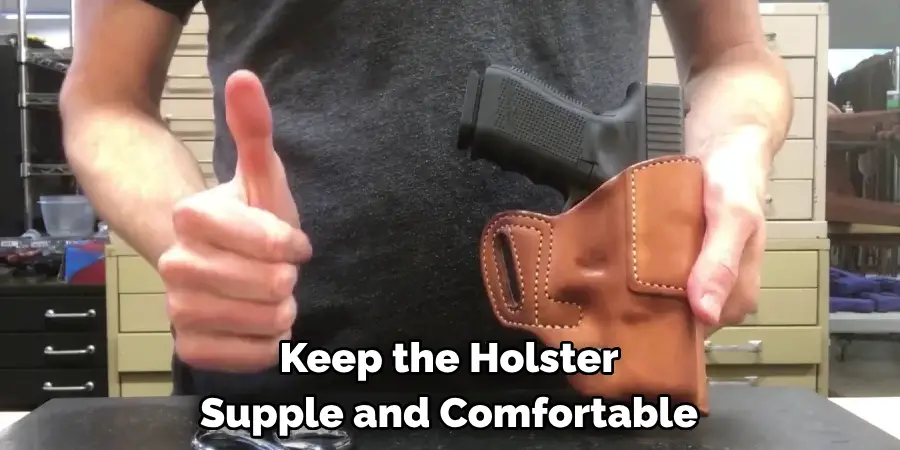
Leather holsters are a popular choice for firearm owners due to their durability and classic look. However, over time, leather can become stiff and rigid, making it difficult to draw your weapon smoothly. This is where a leather holster insert comes in.
A leather holster insert is a simple yet effective tool designed to help you stretch out your leather holster. These inserts are typically made of hardwood or other durable materials and are shaped to fit the specific size and shape of your holster.
To use a leather holster insert, simply insert it into your holster and leave it in place for the recommended amount of time. This process will gently stretch out the leather, making it more pliable and easier to draw from.
10. Wear and Flex Method:
The most natural way to stretch a leather holster is by wearing it regularly. Insert the unloaded firearm into the holster and wear it for extended periods, allowing your body heat and movements to gradually stretch the leather. This method is ideal for achieving a personalized fit over time.
To speed up the process, you can also flex the leather by gently bending and flexing it with your hands. Although this method may not be as effective as wearing the holster, it can still help to break in the leather and make it more comfortable to wear.
Conclusion
In conclusion, mastering the art of stretching a leather holster ensures a comfortable and secure fit, essential for firearm enthusiasts and professionals alike. By employing the outlined techniques and best practices, individuals can effectively adjust leather holsters to accommodate their firearms while maintaining durability and integrity.
Whether utilizing natural stretching methods through regular wear, applying heat application techniques, or using mechanical stretching devices, it’s crucial to approach the process with patience and care. Post-stretching care, including conditioning and monitoring for signs of wear, helps preserve the leather’s quality and longevity.
Hopefully, this article gave you some helpful tips about how to stretch leather holster successfully, so now that you have the proper knowledge on how to get the job done, why not give it a try today?

